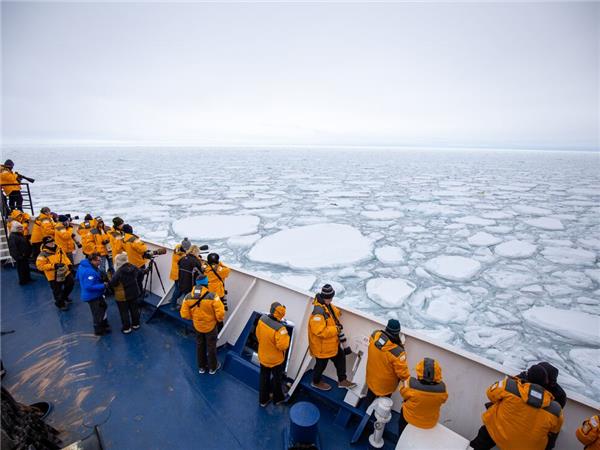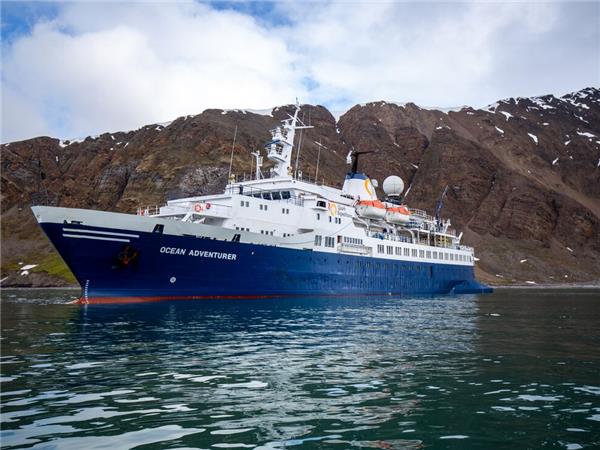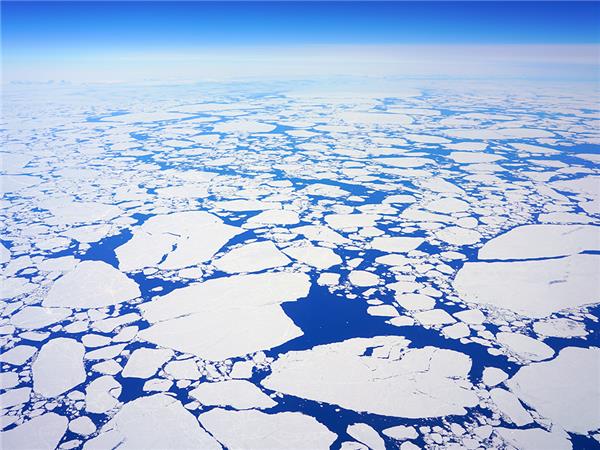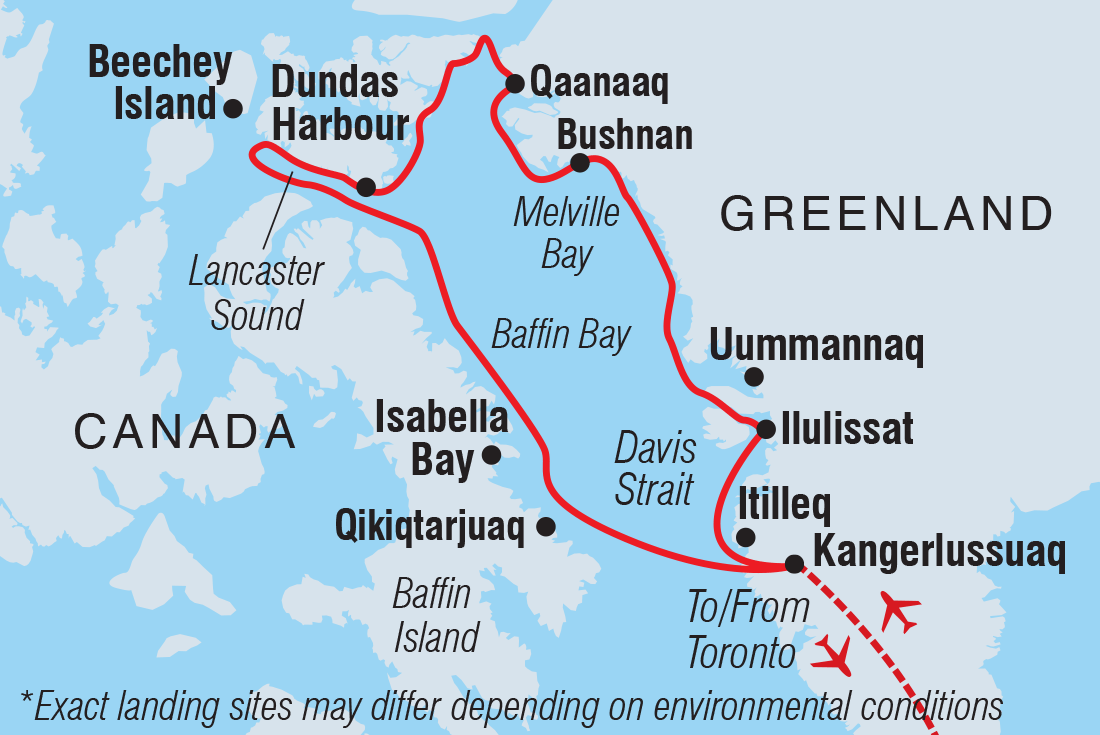Canada and Greenland western Arctic cruise








Price
US $20990US $14693excluding flights
Description of Canada and Greenland western Arctic cruise
Map

Check dates
For departure dates contact us on 1-866-821-6866
Travel guides
Evocative names – Svalbard, Longyearbyen, Disko Bay, the Northwest Passage – fall softly across the Arctic map, conjuring images of midnight sunshine,...
Responsible Travel
As the pioneers of responsible tourism, we've screened this (and every) vacation so that you can travel knowing it will help support the places and people that you visit, and the planet. Read how below.
Planet
We believe it is our responsibility to protect and conserve the destinations we visit. In protecting the Arctic and hopefully instilling a sense of environmental stewardship in our clients, we employ a range of methods and initiatives. All our Arctic trips operate under the guidelines set by AECO, the Association of Arctic Expedition Cruise Operators, and we aim to deliver “respectable, environmentally-friendly and safe expeditions in the Arctic”. In working together with AECO, we ensure that all our expeditions are operated with the utmost consideration for the vulnerable natural environment. Hence, we encourage our passengers to adhere the following guidelines:1. Leave no lasting signs of visiting
Is imperative that visitors do not leave litter behind, this includes small items such as cigarette butts. Do not engrave on rocks or buildings and do not build cairns, rearrange stones or in any other way leave visible signs of a visit. In addition, visitors must watch their footing to protect the flora and vegetation and avoid path-making. Avoid stepping on flowers or plant beds if possible.
2. Do not pick flowers
In some parts of the Arctic flora is protected by law, in others not. But AECO regards all flora as protected and asks not pick flowers or other plants.
3. Do not take anything away
We encourage passengers to leave the Arctic as it is. Cultural remains are protected. In addition, we ask passengers to leave stones, bones, antlers, driftwood and other items where they are.
4. Do not disturb animals and birds
AECO regards all fauna in the Arctic as protected and will avoid disturbing animals and birds as much as possible. If close to animals and nesting birds, avoid making loud noises and keep conversation low and calm. We control maximum group sizes when making landings and excursions and enforce a minimum distance from wildlife.
5. Leave cultural remains alone
Cultural remains and an extended zone of 100 meters surrounding the remains are protected by law. It is important that passengers are conscious of where they stand or walk and take care to move around, not in between, objects. Passengers must not take any items with them or attempt to touch or rearrange objects.
6. Take the polar bear danger seriously
Polar bears are potentially dangerous animals, but also extremely vulnerable. It is of the utmost importance that passengers follow guide instructions in all circumstances.
7. Respect local culture and local people
When visiting local communities, passengers must remember that they are guests, and to respect people and local cultures. AECO will make every effort to ensure that our visits to local communities have positive impact.
8. Be safe
Travel in Arctic areas may involve various risks. Rule number one is to always pay attention and follow the instructions from expedition leaders and guides. It is warranted that passengers never stray from the group.
While on our Arctic expeditions, our on-board expedition team and experts in various fields reveal not only the beauty of the Arctic realm through guided walks and lectures, but also through talks on the conservation issues this fragile habitat faces.
People
With some exceptions, the Arctic region is characterised as a large wilderness area with few small remote towns and settlements, often with an Inuit population. Only a few towns and settlements in the Arctic are connected or acceptable by roads. Contact with the outside world may therefore be limited for the greater part of the year, this means that for small and sometimes isolated towns or settlements in the Arctic, our landings are a welcome opportunity for the community in support of their income. The locals are often eager to showcase their culture, ancient crafts and traditions.Since tourism in the Arctic region is growing rapidly, it is of paramount importance that anyone involved is conscious of the economic, social and cultural impact increased tourism may have locally. We hand out pre-departure information to inform passengers of our responsible travel policies and advice on culture etiquette and ways in which to engage with local communities.
We encourage all our clients to respect local cultures and adhere to the following rules, set by AECO:
• Work against prejudiced attitudes.
• Respect privacy; keep a good distance from private houses and never glance or photograph through private windows.
• Talk to and not about the local people.
• Do not visit graveyards or other areas of religious or cultural significance without permission.
• Ask before photographing – a hesitation means NO.
• Cairns may be signposts – do not alter them.
• Never barter or import banned substances to a community.
• It is encouraged for visitors to buy local souvenirs and products but be aware of the legalities of importing/transporting purchases into other countries.
Popular similar vacations
Greenland cruise and northern lights
From €4250 - €13005 9 days excluding flights
The world's longest fjord & spectacular Aurora Borealis
Greenland photography tour, Uummannaq & Ilulissat
From £4770 10 days excluding flights
Photograph epic and remote winter landscapes and the aurora
East Greenland cruise
From £3580 9 days excluding flights
Dramatic Arctic Mountains, Inuits, Towering Icebergs Whales










